
Gas stoves offer immediate heat control and a traditional cooking experience, while induction cooktops provide faster heating, energy efficiency, and enhanced safety through magnetic induction technology. Explore the rest of this article to discover which option best suits your cooking style and kitchen needs.
Table of Comparison
| Feature | Gas Stove | Induction Cooktop |
|---|---|---|
| Heating Method | Open flame | Electromagnetic induction |
| Energy Efficiency | 40-55% | 80-90% |
| Cooking Speed | Moderate | Faster heating |
| Temperature Control | Visual flame adjustment | Precise digital control |
| Safety Features | Potential gas leaks, open flame risk | Auto shut-off, cool surface |
| Cookware Compatibility | All types | Magnetic cookware required |
| Installation | Gas line needed | Electric outlet needed |
| Cleaning | More effort, removable parts | Easy, flat surface |
| Cost | Lower initial cost | Higher initial cost |
Introduction: Gas Stove vs Induction Cooktop
Gas stoves provide instant heat with visible flames, allowing precise temperature control favored by many chefs. Induction cooktops use electromagnetic fields to heat cookware directly, offering faster cooking times and improved energy efficiency. Your choice depends on cooking style preferences, safety considerations, and kitchen energy sources.
How Gas Stoves Work
Gas stoves operate by burning natural gas or propane to produce an open flame, which directly heats pots and pans for cooking. The flow of gas is controlled by valves, allowing adjustment of flame size and heat intensity. This direct flame provides instant heat changes, making gas stoves preferred for precise temperature control in cooking.
How Induction Cooktops Work
Induction cooktops use electromagnetic fields to directly heat pots and pans, providing precise temperature control and faster cooking times compared to gas stoves. Unlike gas burners that rely on open flames, induction cooktops generate heat only when compatible cookware is placed on their surface, enhancing energy efficiency and safety. Your cooking experience benefits from less heat loss and easier cleanup due to the smooth glass-ceramic surface.
Energy Efficiency Comparison
Induction cooktops offer superior energy efficiency compared to gas stoves, converting about 85-90% of energy into heat directly on the cookware, whereas gas stoves achieve only around 40-55% efficiency due to heat loss in flames. Induction technology uses electromagnetic fields to heat pots and pans quickly and accurately, reducing wasted energy and cooking times. This higher efficiency translates into lower energy consumption and cost savings over time, making induction cooktops a more eco-friendly choice for modern kitchens.
Cooking Speed and Heat Control
Gas stoves provide instant heat with flames that allow precise temperature adjustments, making them ideal for dishes requiring quick changes in cooking intensity. Induction cooktops heat faster than gas by using electromagnetic energy to directly warm pots and pans, resulting in reduced cooking times and consistent temperature control. Your choice depends on whether you prioritize rapid heat responsiveness or efficient, even cooking speeds.
Safety Features and Risks
Gas stoves pose risks such as open flames, gas leaks, and carbon monoxide emissions, requiring proper ventilation and careful monitoring to prevent accidents. Induction cooktops offer enhanced safety with no open flames, automatic shut-off features, and a cool-to-touch surface that reduces burn risks. Despite their safety advantages, induction cooktops depend on compatible cookware and require electrical power, which can limit usability in some situations.
Cost Analysis: Purchase and Operating Expenses
Gas stoves typically have lower upfront costs, averaging between $300 and $1,000, while induction cooktops range from $1,000 to $3,000 depending on features and brand. Operational expenses for gas stoves tend to be higher due to fluctuating natural gas prices, whereas induction cooktops offer greater energy efficiency, reducing electricity bills by up to 30%. Your choice impacts long-term savings, with induction cooktops often proving more cost-effective over time despite higher initial investment.
Maintenance and Cleaning
Gas stoves require frequent cleaning of burner grates and drip pans to prevent food residue buildup and ensure efficient flame distribution, while induction cooktops feature smooth, flat surfaces that are easier to wipe down and resist stains or spills. Induction cooktops have fewer components exposed to grease and soot, reducing the need for deep cleaning and prolonging the appliance's lifespan. Proper maintenance of gas stoves involves regular inspection of burners for clogging, whereas induction cooktops demand minimal upkeep due to their sealed, electronic design.
Environmental Impact
Gas stoves emit significant amounts of carbon dioxide and methane, contributing to greenhouse gas emissions and indoor air pollution. Induction cooktops operate using electricity, which can be sourced from renewable energy, resulting in a lower overall carbon footprint. Choosing an induction cooktop can reduce your environmental impact by improving energy efficiency and minimizing harmful emissions.
Which One Should You Choose?
Gas stoves offer precise flame control and work without electricity, making them ideal for chefs who prioritize immediate heat adjustments and traditional cooking methods. Induction cooktops provide faster heating, energy efficiency, and enhanced safety with a cool-to-touch surface, perfect for modern kitchens focused on clean and efficient cooking. Choosing between the two depends on your cooking style, kitchen setup, and preference for speed versus versatility.
 homyna.com
homyna.com